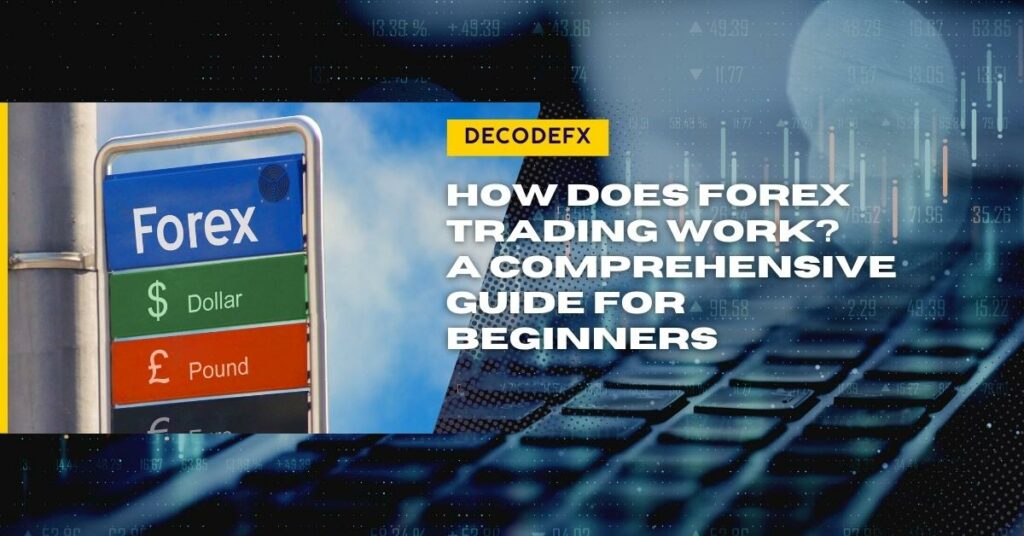Navigating the financial market can be quite challenging, especially because there are many tradable assets with numerous basic and technical concepts to learn. The forex market is indeed the most traded financial market, with a large trading volume and endless trading opportunities to take advantage of.
If you need to learn what forex trading means and how it works, then this article is right for you.
What is Forex trading?
Forex trading involves the exchange of one currency for another. Besides the exchange of currencies to facilitate commerce and travel, forex brokers now provide an avenue for retail traders to speculate on the price of currencies for profit. The forex market is the largest financial market in the world, as currencies are constantly being exchanged as their value, supply and demand fluctuate.
How does Forex Trading work?
To trade the forex market, you need to understand the factors that influence currency prices, analyze them, and determine whether the value of a currency is likely to rise or fall. If your analysis suggests that a currency will increase value, you buy. But if your analysis indicates that a currency will weaken, you sell. These currencies are traded in pairs, and forex traders buy one currency and sell the other simultaneously.
The first currency listed in a currency pair is the base currency, while the second is the quote currency. There are three classes of currency pairs:
- Major Pairs: Major currency pairs contain the United States dollar paired with a currency from a developed economy. These are highly liquid pairs because the presence of the US dollar makes them highly traded, with a large number of market participants. They’re the most traded forex pairs, and some of them include; EUR/USD, AUD/USD, and USD/CHF.
- Minor Pairs: Minor currency pairs are also known as crosses. These pairs contain currencies of developed economies, excluding the US dollar. They are liquid and volatile pairs, and some of them include; AUD/JPY, CAD/CHF, and EUR/GBP.
- Exotic Pairs: Exotic currency pairs contain currencies from developed economies paired with currencies from emerging economies (or currencies from other developed economies that are less traded). They are known for their high volatility and relatively low liquidity. Examples include; AUD/MXN, GBP/ZAR, and USD/NOK.
To determine which currency pairs to trade, you need to carry out an in-depth analysis of the forex market using technical and fundamental analysis methods.
Technical analysis involves using indicators, trading theories, and technical tools to analyze the price charts. It aims to predict price movement by evaluating past price behavior. Indicators such as moving averages, Bollinger Bands, and MACD analyze price data and use this as a benchmark to forecast the likely direction of price movement.
This analysis also relies on patterns that repeat in the forex market. These forex chart patterns show the interaction of buyers and sellers in the forex market. Fundamental analysis involves the analysis of political, economic, and social factors that affect the value of a currency. These include news releases, exchange rates, political stability, etc.
Now that you understand how forex trading works, let’s discuss the types of forex markets.
Types Of Forex Market
Spot Forex Market
The spot forex market provides an avenue for forex traders to exchange currencies immediately at the current exchange rate. This is the most popular type of forex trading that retail traders can participate in through a CFD broker. Banks and financial institutions also carry out spot trading by exchanging currencies instantaneously at the current market prices.
Forward Forex Market
Traders in the forward forex market trade by entering a contract or an agreement to sell a currency at a specified price sometime in the future. The two participants can be individuals or large companies.
Futures Forex Market
The forex market can also be traded with futures contracts. The futures market involves trading terms similar to the forward market. However, futures contracts require centralized exchanges to facilitate them. It is generally more liquid than the forward forex market.
Factors Affecting the Forex Market
Central Banks
A central bank is a financial institution that controls the distribution and valuation of currencies and makes monetary policies to direct the activities of banks within a country. The central bank can directly influence the forex market by controlling the value of currencies. If the central bank decides to inject more money into the economy, then the value of a currency could drop.
The central bank decisions and news releases also influence the value of a currency. Interest rates can affect borrowing and investment decisions, significantly affecting currency valuation.
News Reports
News reports are key factors that influence the forex market. A positive, high-impact news report can encourage the influx of investors into a country, leading to an increase in the demand for a currency.
This can increase the value of that currency and improve the nation’s economic outlook.
Economic Data
The economic data and reports such as unemployment rate, consumer price index, and inflation can guide central banks’ decisions. This also affects the decisions of investors and other forex market participants.
Market Sentiment
The trading environment and market sentiment determine the nature of investments and currency purchases that are prevalent. Investors tend to invest in ‘safe haven’ assets and currencies like the Japanese Yen, Swiss Franc, and gold in risk-off environments. In risk-on settings, investors are willing to take more risks and move their investments away from ‘safe-haven’ assets to other currencies.
Banks and Other Financial Institutions
Currency prices are significantly affected by the volume of orders placed by banks and other financial institutions. These orders can influence the supply and demand of a currency.
Types of Forex Trading
There are four main styles of forex trading. As a new trader, you can try out these methods and choose which one suits your trading needs.
Scalping
Scalping involves trading short-term market swings and price displacements in the forex market. These trades are often short-lived and may last for seconds or minutes before the trade is closed. It involves moving in and out of trading positions to accumulate profits during the trading session. Scalpers often utilize lower time frames for trade entries and management.
Day Trading
Day trading is a short-term trading method in which traders execute and manage trades and exit before the trading day ends. Day trading aims to capture significant profits during the trading day without leaving a trade open till the next day. As a result, day traders typically hold trades longer than scalpers. However, day trading isn’t everyday trading. Make sure you only trade when the conditions are right.
Swing Trading
Swing trading involves trading more significant price swings for long-term gains. Swing traders usually have trade positions open for more extended periods (days or weeks) than day traders and scalpers. They analyze the forex charts and form a long-term bias, after which trades are executed in line with this bias. These trades may take long periods before coming to completion. Hence, swing traders are usually patient enough for their bias to come to fruition.
Position Trading
Position trading is a long-term trading style that profits from long-term market trends that may persist from months to years. A position trader is usually an experienced trader with an in-depth understanding of the factors that affect the forex market. To succeed as a position trader, you need to trust your analysis and avoid being distracted by other traders’ biases.
Foundational Concepts of Forex Trading
As a new forex trader, there are certain forex trading concepts that you need to know in order to trade forex successfully. These are foundational concepts, and some of them include;
Spread
Spread is the difference between the ask(buy) and bid(sell) prices of a currency pair. You have to buy at the asking price and sell at the bidding price of a currency pair. The spread is an essential term because it can affect the execution of your trades and your risk per trade. Liquid assets like major currencies usually have lower spreads that facilitate trade execution.
Leverage
Having leverage in forex means getting access to ‘borrowed’ funds from your broker to increase the purchasing power of your deposited funds. For instance, if you have a 1:100 leverage, every $1 you deposit has a purchasing power of $100.
Stop Loss
The stop loss is a trade order that prompts your broker to close out your trade once the price trades to a specific level. This helps to protect your trading capital by limiting your risk exposure.
Risk
Risk is the percentage (or amount) of the capital you are willing to lose on a forex trade. You have to pre-determine this before placing a trade.
Long/Short Position
To enter a long position or ‘go long’ means placing a buy trade. Buying a currency pair such as EUR/USD means you’re buying the euro and selling the US dollar.
To enter a short position of ‘go short’ means placing a sell trade. For example, selling a currency pair such as EUR/USD means selling the euro and buying the US dollar.
Open an Account With Decode Global and Start Trading
Now that you understand how forex trading works, choosing the right trading tools and resources is imperative. Of course, the most crucial trading resource is a reputable forex trading platform. So open a trading account and start trading today with Decode Global!

